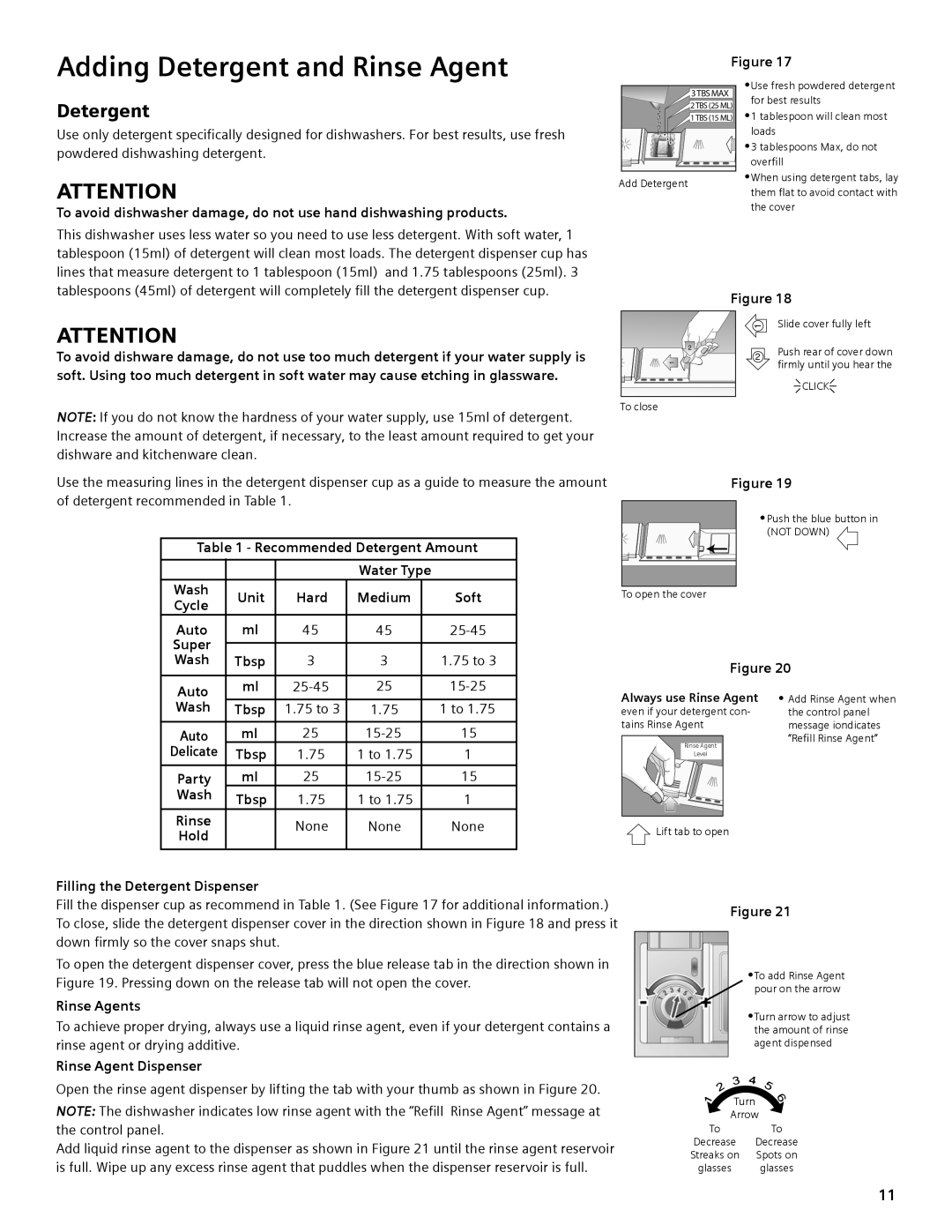
Adding Detergent and Rinse Agent
Detergent
Use only detergent specifcally designed for dishwashers. For best results, use fresh powdered dishwashing detergent.
ATTENTION
To avoid dishwasher damage, do not use hand dishwashing products.
This dishwasher uses less water so you need to use less detergent. With soft water, 1 tablespoon (15ml) of detergent will clean most loads. The detergent dispenser cup has lines that measure detergent to 1 tablespoon (15ml) and 1.75 tablespoons (25ml). 3 tablespoons (45ml) of detergent will completely fll the detergent dispenser cup.
ATTENTION
To avoid dishware damage, do not use too much detergent if your water supply is soft. Using too much detergent in soft water may cause etching in glassware.
NOTE: If you do not know the hardness of your water supply, use 15ml of detergent. Increase the amount of detergent, if necessary, to the least amount required to get your dishware and kitchenware clean.
Figure 17
|
|
|
|
|
|
|
|
| •Use fresh powdered detergent | |
|
|
|
|
| 3 TBS MAX | |||||
|
|
|
|
|
| for best results | ||||
|
|
|
|
| 2 TBS (25 ML) |
| ||||
|
|
|
|
|
| •1 tablespoon will clean most | ||||
|
|
|
|
| 1 | TBS (15 ML) |
| |||
|
|
|
|
|
|
|
|
| loads | |
|
|
|
|
|
|
|
|
| •3 tablespoons Max, do not | |
|
|
|
|
|
|
|
|
| overfll | |
|
|
|
|
|
|
|
|
| •When using detergent tabs, lay | |
Add Detergent | ||||||||||
| them flat to avoid contact with | |||||||||
|
|
|
|
|
|
|
|
| ||
|
|
|
|
|
|
|
|
| the cover | |
Figure 18
1 | Slide cover fully left | |
2 | Push rear of cover down | |
2 | ||
frmly until you hear the | ||
1 | ||
| ||
| CLICK |
To close
Use the measuring lines in the detergent dispenser cup as a guide to measure the amount of detergent recommended in Table 1.
Table 1 - Recommended Detergent Amount
|
|
| Water Type |
| |
Wash | Unit | Hard | Medium |
| Soft |
Cycle |
| ||||
|
|
|
|
| |
Auto | ml | 45 | 45 |
| |
Super |
|
|
|
|
|
|
|
|
|
| |
Wash | Tbsp | 3 | 3 |
| 1.75 to 3 |
|
|
|
|
|
|
Auto | ml | 25 |
| ||
|
|
|
|
| |
Wash | Tbsp | 1.75 to 3 | 1.75 |
| 1 to 1.75 |
|
|
|
|
|
|
Auto | ml | 25 |
| 15 | |
Delicate | Tbsp | 1.75 | 1 to 1.75 |
| 1 |
|
|
|
|
|
|
Party | ml | 25 |
| 15 | |
Wash | Tbsp | 1.75 | 1 to 1.75 |
| 1 |
|
| ||||
Rinse |
| None | None |
| None |
Hold |
|
| |||
|
|
|
|
| |
|
|
|
|
|
|
Filling the Detergent Dispenser
Fill the dispenser cup as recommend in Table 1. (See Figure 17 for additional information.) To close, slide the detergent dispenser cover in the direction shown in Figure 18 and press it down frmly so the cover snaps shut.
To open the detergent dispenser cover, press the blue release tab in the direction shown in Figure 19. Pressing down on the release tab will not open the cover.
Rinse Agents
To achieve proper drying, always use a liquid rinse agent, even if your detergent contains a rinse agent or drying additive.
Rinse Agent Dispenser
Figure 19
•Push the blue button in (NOT DOWN) ![]()
To open the cover
Figure 20
Always use Rinse Agent | • Add Rinse Agent when | |||
even if your detergent con- | the control panel | |||
tains Rinse Agent | message iondicates | |||
|
|
|
| “Refll Rinse Agent” |
|
|
|
| |
|
| Rinse Agent |
|
|
|
| Level |
|
|
|
|
|
|
|
|
|
|
|
|
|
|
|
|
|
![]() Lift tab to open
Lift tab to open
Figure 21
•To add Rinse Agent pour on the arrow
•Turn arrow to adjust the amount of rinse agent dispensed
Open the rinse agent dispenser by lifting the tab with your thumb as shown in Figure 20.
NOTE: The dishwasher indicates low rinse agent with the “Refll Rinse Agent” message at the control panel.
Add liquid rinse agent to the dispenser as shown in Figure 21 until the rinse agent reservoir is full. Wipe up any excess rinse agent that puddles when the dispenser reservoir is full.
Turn
Arrow
To To
Decrease Decrease Streaks on Spots on
glasses glasses
11
